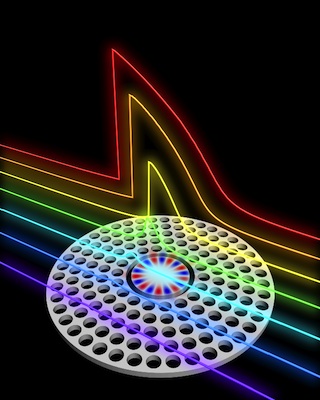Discovering New Behaviors of Silicon Photonic Nanocavities

Photonic nanocavities are a key component in many applications because of their capability of trapping and storing photons and enhancing interactions of light with various functional materials and structures. The strength of such light–matter interactions depends crucially on the photon energy stored inside the cavities. Therefore, it is usually desirable to obtain large intracavity energy, or a large number of intracavity photons. The maximal number of photons that can be stored in silicon photonic cavities is limited by the free-carrier and thermo-optic effects at room temperature.
 In a paper published in Scientific Reports, a group of Yale engineers report their discoveries of new behaviors of silicon photonic nanocavities. The group performed the first experimental study of optical nonlinearities in ultrahigh-Q silicon disk nanocavities at cryogenic temperatures in a superfluid helium environment. Under this condition, the free-carrier and thermo-optic effects are greatly reduced and the cavities exhibit strikingly new behaviors compared with their normal operation at room temperature. As a result, the group is also successful in obtaining record large stored energy in these photonic nanocavity devices and contends that this innovation has far-reaching impact on high-power photonics, nonlinear photonics, and quantum optomechanics.
In a paper published in Scientific Reports, a group of Yale engineers report their discoveries of new behaviors of silicon photonic nanocavities. The group performed the first experimental study of optical nonlinearities in ultrahigh-Q silicon disk nanocavities at cryogenic temperatures in a superfluid helium environment. Under this condition, the free-carrier and thermo-optic effects are greatly reduced and the cavities exhibit strikingly new behaviors compared with their normal operation at room temperature. As a result, the group is also successful in obtaining record large stored energy in these photonic nanocavity devices and contends that this innovation has far-reaching impact on high-power photonics, nonlinear photonics, and quantum optomechanics.
"We are very excited about these discoveries. Not only did we achieve a new record of intracavity photon number in silicon nanocavities, we also open the way for studying quantum optomechanics by taking advantage of the high thermal conductivity, low density, and low viscosity of the superfluid helium." said Xiankai Sun, the paper's lead author. Other co-authors include Xufeng Zhang, Carsten Schuck, and Hong Tang, associate professor of electrical engineering, physics, and applied physics.
Click here to read the paper: Nonlinear optical effects of ultrahigh-Q silicon photonic nanocavities immersed in superfluid helium. Scientific Reports 3, 1436 (2013).
Image: Novel nonlinear optical effects discovered in silicon nanocavities in the superfluid helium environment. The cavity resonance moves toward shorter wavelengths as the power cranks up, rendering a distinct shark-fin feature in their transmission spectra. (Illustration by Xufeng Zhang)

